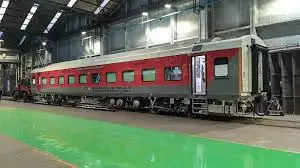Difference Between Third AC & AC - 3 Economy Coaches Explained

AC-3 Economy, a recent addition to train coaches alongside the traditional First AC, Second AC, Third AC, and Sleeper classes, has sparked curiosity among passengers due to its perceived similarities and differences with the existing Third AC class. The Indian Railways, known for its diverse accommodations tailored to varying needs and budgets, has introduced these new coaches to cater to the evolving demands of travelers. Delving into the specifics, let's unravel the distinct facets of the AC-3 Economy in comparison to the familiar Third AC class.
Essentially, the AC-3 Economy class mirrors the layout and amenities synonymous with the Third AC coaches. However, a notable variance lies in the seating capacity. While the conventional Third AC typically accommodates 72 passengers, the AC-3 Economy stands out by offering an increased capacity of 83 seats within the same space.
These newly conceptualized coaches have been meticulously crafted to enhance the travel experience for commuters, combining augmented seating availability with an upgraded interior. This design overhaul ensures that passengers not only benefit from a more spacious environment but also enjoy improved amenities, including an optimized air-conditioning system. The interior arrangement and lighting arrangements have been meticulously tailored to accommodate the preferences of every individual aboard, ensuring a comfortable journey for all.
Moreover, to distinguish these coaches from their counterparts, the identifying codes for Third AC coaches, such as B1, B2, B3, are replaced with designations like M1, M2, M3 for the AC-3 Economy class. This alteration in nomenclature simplifies the identification process for passengers seeking these newly introduced coaches.

The arrival of the AC-3 Economy class marks a significant addition to the train coach hierarchy, but it's essential to emphasize that its implementation isn't synonymous with the complete replacement of the established Third AC coaches across all train services. Instead, the integration of AC-3 Economy is a deliberate and selective move, aimed at offering passengers an alternative choice while retaining the conventional Third AC coaches.
In essence, the AC-3 Economy class represents an evolution or a modern iteration of the conventional Third AC setup. Its introduction primarily focuses on augmenting the capacity available to passengers while simultaneously enhancing the overall interior ambiance and facilities. This deliberate augmentation in seating capacity while refining the amenities reflects a strategic upgrade by the Indian Railways. It's not merely an overhaul but an alignment with the evolving demands and expectations of the passengers.
This nuanced approach underscores the Railways' commitment to diversifying its service offerings. The intention is not to entirely phase out the established Third AC coaches but rather to supplement them with a contemporary alternative. By doing so, the Railways can accommodate a wider spectrum of preferences and financial considerations among its diverse passenger base.
The strategic integration of AC-3 Economy showcases a proactive effort by the Indian Railways to cater to the multifaceted needs of travelers. It represents a responsive adaptation to the changing dynamics of travel, ensuring that passengers have options that suit their preferences and budgets.
This enhancement is part of a broader endeavor to maintain a flexible and accommodating service framework that acknowledges and accommodates the diverse economic considerations and preferences of passengers. The Indian Railways' commitment to this level of versatility underscores its dedication to offering an inclusive and comfortable travel experience to all passengers, irrespective of their varying needs and constraints.



